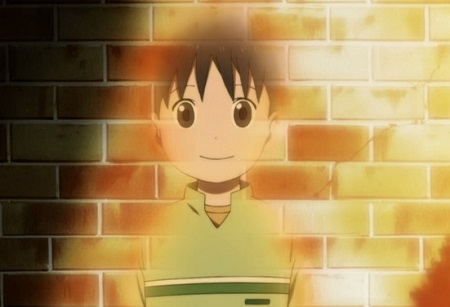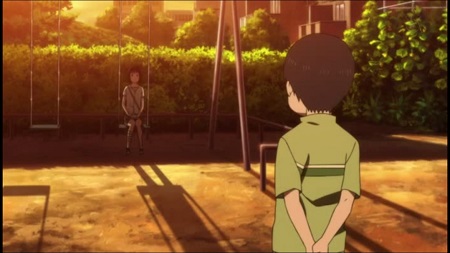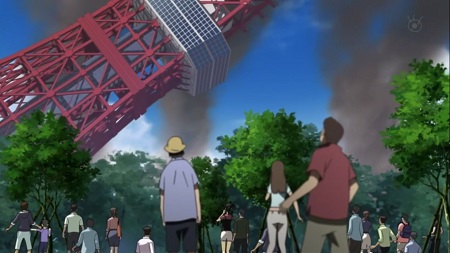
An essay on
Tokyo Magnitude 8.0
Linda Tran, Swarthmore College, 2015
In Natsuko Takahashi's award winning anime, Tokyo Magnitude 8.0, the audience gets a realistic glimpse of the results of a hypothetical earthquake in Tokyo; buildings gone, cars and streets smashed to bit and wreckage everywhere the eye can see. There are characters in the anime who feel as though their life have vanished, while others that were injured experience pain like no other. In the face of disaster, the audience begins to understand that hope can be one of the most difficult things to hold onto. However, in this anime, we are given an emblem of hope, not only one that is fictional but one that we can hold onto in reality as well. This emblem is one of the main characters of the series, Yuuki Onozawa. Experiencing the earthquake in Tokyo first-hand with Mirai, his older sister, and Mari, a young single mother the two meet, Yuuki is still able to keep his strong hold on hope.
At the beginning of the series, Yuuki is seen as a typical younger brother: annoying to his older sister, full of child-like wonder, and inexperienced to the harsh realities of the world. However, through the series, the audience sees Yuuki grow as he eventually becomes a guiding light for Mirai. Through the realistic aspects of the series, Yuuki also is seen as a symbol of hope for the audience during a time of disaster
Experiencing the disaster for himself, Yuuki, being a young boy, does not know how to react since he does not fully understand the situation he is in. Because of the earthquake, the chances that he will be able to return home soon to his family are slim but it is what he looks forward to the most. However, in this scene (17:15; see Figure 2), we see Yuuki wanting to find some type of hope as he tries to go to the Tokyo Tower where his house is visible from the observatory deck. Stopped by his sister, Yuuki breaks down in tears asking if their mother and father are dead. As Mirai also begins to cry, it is here that Yuuki begins to understand that the world will not always seem like a happy place. However, in the same scene, Yuuki is able to find a reason to feel hope again when the two are found by strangers. Comforting the children, these strangers show kindness and compassion that give strength especially in such a chaotic time. While it can be difficult to show kindness and be hopeful, it is these traits that help others, as well as ourselves, be strong in a disaster. The scene then ends with the two siblings promising to return home to give their mother her birthday present. Even though Yuuki recognizes his parents might be gone, he remains hopeful that everything will be alright and moves forward.
Through much of the anime, Yuuki also serves as a guiding light of hope for Mirai. In this part, (12:55; see Figure 3) Mari believes her mother and daughter have died in her absence. But Yuuki refuses to believe they are dead and convinces his sister to continue searching for Mari's mother and daughter. The two search every area they can think of but Yuuki still refuses to give in and eventually ends up being right. Yuuki and Mirai find Mari's family and are able to reunite the three. Even though Mirai believed their search would be useless, it was due to Yuuki's hopefulness and determination that they were able to finally find Mari's family.
Additionally, we are also able to see Yuuki's guidance when Yuuki saves his sister and his friend once the house they are in begins to crumble during another aftershock (18:37; see Figure 4). Yuuki huddles on the floor on the opposite side of Mirai which prompts her to run to him right before half of the house breaks apart. Yuuki is still able to save his sister one more time before Mirai realizes that Yuuki has actually died. Continuing into the next episode, (3:40; see Figure 5) Mirai has finally learned of her younger brother's death and because of this, she believes she won't be able to face her parents without him. While Mirai is sitting alone, a ghost of Yuuki comes to her and tells her to come home with him. The scene continues on with Yuuki telling his sister that he wants for them to return home together. Shocked by his words, Mirai promises that no matter what she will bring him home. Although Mirai understands that he is not actually there, she tries to grasp his hand and they two make the final trek home. No matter the circumstances, Yuuki continues to guide his sister home and back to their parents.

Figure 5
The series ends with Mirai's final goodbye to her younger brother (18:25; see Figure 6). Mirai resolves to start moving on with her life while forever keeping Yuuki in her life and her heart. In her goodbye, she tells Yuuki he will always be a part of their home in both spirit and with his belongings. In addition, Mirai promises to speak to Yuuki whenever she feels the need. Rather than holding her feelings inside, she will continue speaking to Yuuki as though he were still there. From the beginning, Mirai and Yuuki journeyed together with Mari in the hope of returning home to their families. However, there were many times along the way Yuuki continued to protect his sister both from the dangers of the earthquake and herself. Despite being gone, he led his sister home to reunite his family again so that they could be happy even without him. Even in the end, Yuuki will continue to be a guiding light of hope for his sister to continue on with her life knowing he is still there with her.
In the last scene, we also see the citizens of Tokyo rebuilding and recovering from the disaster. Families grieve for their loved ones, students continue on with classes, and everyone begins moving on. It is the realism of the anime, as well as the character of Yuuki, that creates the sense of hope for the audience to hold on to. Part of this realism is created in the depictions of the characters. In many animes, the drawings of the characters tend to be on the fantastical side. Hair styles of often unnatural in both style and color; eyes are drawn as big and unique compared to natural eyes. However, in the drawing of Yuuki, we see simplicity. His hair, clothes, and eyes are all simple. This simple depiction of the characters makes them more relatable to the audience. Even as an anime, the characters seem more life-like, possibly more human.
Furthermore, it is the authors' attention to detail and simplistic use of scenarios that also add to the anime's realism. For the falling of the Tokyo Tower in the series (18:51; see Figure 7), the authors create a Tokyo Tower that looks almost exactly like the one that stands in the Shiba-koen district of Minato, Tokyo. Standing at over 1000 ft, the tower was originally made as a broadcasting station for Tokyo but is now one of the most defining tourist attractions for the city. Despite being hypothetical, this scene also realistically depicts the falling of the Tower, from the initial creaking sounds indicating instability, to the lower supports of the tower crumbling, and finally the impact and damage that is created the second the tower hits the ground. The detail in this scene is one that continues through the entire series. The artists of the anime put detail into every aspect of the series to make it seem even more life-like. This includes every situation we see our characters put in.

Figure 7
While the detail is exceptional, the situations are simple. For example, in this scene (4:55; see Figure 8), Mirai needs to use the bathroom but is too embarrassed to let the other two know. But Mari notices and runs to retrieve a portable toilet which embarrasses Mirai further. It's a simple and small situation but this scene demonstrates two important features. The first is the humor in this scene. Many of the other situations the characters are put in throughout the series are much like this one. The authors add in a hint of humor as a technique to keep the series serious, as well as light-hearted. This makes the characters, and the anime, more enjoyable. The second feature is that this situation can happen to anyone. It is not one that would occur only in anime but in a real-life situation as well which, again, makes it easier for the audience to relate to, thus, adding to the realism.
With its combination of realism and simplicity, the anime, itself, gives the audience a chance to experience a disaster without having to experience one first-hand. The audience is able to view much of what occurs when a disaster strikes, both the good and the bad. We witness the earthquakes and its aftershocks, along with the damage to the city, and the multitudes of people that are affected by the disasters. In addition, as the audience, we see how people come together to help each other through these events and the kindness they show to one another. The realness of the anime is so prevalent that it creates a tie between the audience and the characters, mainly through Yuuki. Even after his death, Yuuki shows the audience that hope can be something both tangible, as well as something we believe in. Whether it is because we have our own children or siblings, it is his character's optimism and hopefulness that most of us can relate to or empathize with. Wanting to reunite his family or striving to make his older sister happy, Yuuki demonstrates to us that hope is something fostered within us during disaster and can continue with us long after.